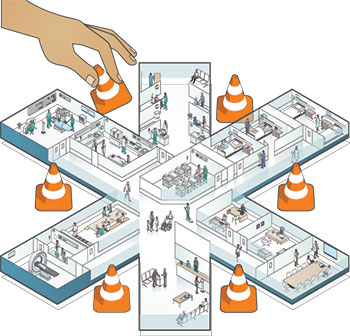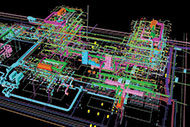 |
Health facilities professionals know that creating a safe environment for patients is vastly more complicated than just implementing effective hand-hygiene programs and installing seamless epoxy flooring to prevent slips and falls.
In today’s health care climate, managers held to increasingly higher standards for performance are charged with creating an entire culture of safety vs. focusing on a series of targets. And that is a much taller order considering that a culture shift encompasses everything from developing a shared mindset among leaders and staff to staying on top of changing laws and regulations to designing the facility — inside and out — for patient and staff safety.
You may also like |
| A new era for patient safety |
For the foreseeable future, hospitals striving to reach long-term goals are setting their sights on key areas that move them closer to those goals, experts say. While many improvements are dictated by codes and regulations, hospitals also are putting in the extra work required to take patient safety to a higher level.
“Many changes are driven by compliance with codes and regulations, which, for the most part, do foster a safe environment, but many health care personnel also realize the importance of going above and beyond that threshold,” says Chad E. Beebe, AIA, CHFM, CFPS, CBO, SASHE, the American Society for Healthcare Engineering (ASHE) deputy executive director of advocacy.
Often that involves a concerted level of teamwork. For example, before launching a new project, some designers and architects are shadowing hospital staff on their daily routines, making notes about potential safety enhancements to improve the design, says Joseph Sprague, FAIA, FACHA, FHFI, principal and senior vice president, HKS, Dallas.
“Factors like room proximity and workflow layout may contribute to stress, fatigue, disruptions and interruptions of the health care staff’s duties that can increase errors and lead to safety incidents,” Sprague says. “What we will do is incorporate changes into the design that address these issues.”
Focus on infection control
For most hospitals, many high-priority safety improvements are connected to infection control, which impacts every area of the facility. Hospitals are making progress in reducing health care-associated infections (HAIs), according to a 2013 HAI progress report from the Centers for Disease Control and Prevention (CDC) that shows an 8 percent decrease in hospital-onset, methicillin-resistant Staphylococcus aureus bacteremia between 2011 and 2013 and a 10 percent drop in hospital-onset Clostridium difficile infections between 2011 and 2013.
Spurred by Affordable Care Act laws tying Medicare reimbursement to HAIs, hospitals are putting considerable time and money into preventing the HAIs that are still a major concern. According to the CDC, one in 20 patients has an HAI on any given day, and there are about 1.7 million cases — leading to 99,000 deaths — of HAIs in U.S. health care facilities each year.
“Infection control is the main focus for hospitals and I don’t see it going away,” says ASHE President-elect Terry M. Scott, CHFM, CHSP, SASHE, system director of engineering services, Memorial Hermann Greater Heights Hospital and Memorial Hermann Southwest Hospital, Houston. “It’s at the forefront of health care now with Medicare reimbursement tied to infection control. Some facilities are losing money and some are gaining, but there are huge financial incentives involved.”
Along with must-have systems, such as room-pressure indicators and alarms for monitoring the direction of airflow into or out of a room, hospitals will continue to explore new infection control technology.
Memorial Hermann spent $600,000 to develop computer dashboards integrated with the hospital’s automated systems that continually measure air temperature and humidity in operating and isolation rooms, Scott says. Another recent addition at Memorial Hermann — “ball-in-the-wall” positive and negative pressure indicators — offer simple, visual cues (red or green pingpong-sized balls) indicating proper or improper airflow direction in isolation rooms, he said.
Technology — particularly innovations that augment manual cleaning and surface disinfection — are increasingly important in environmental services, where workers are more on the front lines of patient safety, says Patti Costello, executive director of the Association for the Healthcare Environment (AHE). “Understanding how, why and if these new tools and applications may be beneficial to patient outcomes is key. Overall, clearly redefining staff core competencies, aligning them with infection prevention and providing ongoing training and education are the three areas environmental services leaders will be targeting to meet their patient safety goals,” Costello says.
Ultraviolet technology, fogging and misting (i.e., ozone mists, vaporized hydrogen peroxide), and adenosine triphosphate monitoring systems to measure organic matter left on surfaces after cleaning and disinfection are some of the technologies hospitals are relying on in greater numbers, says Joan L. Suchomel, AIA, ACHA, EDAC, director at Skidmore, Owings & Merrill LLP, Chicago, and president-elect of the American Institute of Architects/Academy of Architecture for Health.
Hand-hygiene compliance is also getting a technological assist. “There are technologies available to monitor handwashing, helping facilities keep track of whether a staff person washed or not,” says Suchomel. “There is also technology that reminds them to wash their hands.”
Other solutions are less complicated. Something as simple as installing a dedicated hand-washing sink near the door of each patient room makes hand hygiene easier for patients and staff, she says.
Other areas to watch include the increasing use of antimicrobial materials such as copper, microfiber mops and cloths that hold six times their weight in water and don’t need to be “redunked” frequently, as well as cubicle curtains that reduce the risk of bacterial contamination, Suchomel adds.
Along with potential benefits, introducing new products and materials may also create new issues or concerns of which hospitals need to be aware, says Brent Petty, the Association for Healthcare Resource & Materials Management board chair.
“For example, alcohol-based hand sanitizer is a great germ-killing agent, so essentially every hospital added a dispenser at every doorway. The benefit of this product greatly outweighed the risk of having a flammable substance at the door of every patient room," Petty says.
He says it is the mission of the supply chain manager — in conjunction with physicians — to weigh the positives and negatives of each product.
Avoiding patient falls
Facilities managers continue to seek new solutions to a patient safety issue that has existed as long as hospitals have: slips and falls.
Between 30 and 35 percent of patients who fall sustain an injury and, on average, these injuries result in an additional 6.3 days in the hospital, according to the CDC. Because Medicare no longer reimburses for preventable slips and falls in hospitals and limits payment for extended stays, hospitals have financial incentive to invest in the best strategies and products.
However, there are some misconceptions when it comes to potential dangers hidden in long-embraced products and materials.
“I’ve been down this road with hospital CEOs who want the floors to be polished like glass,” Beebe says. “Some of the best flooring materials actually void the warranty if you polish them because they are slip-resistant, but the CEO wants them polished anyway.”
More hospitals are turning to electronic patient lifts designed to lift and transfer patients from one place to another — such as bed to chair or chair to stretcher — to reduce patient falls and staff back injuries. They also are using technology such as bed exit alarms. Flooring materials and accessories that eliminate a potential tripping hazard also are more commonly used, says Suchomel. Beebe says handrails on both sides of the corridors and grab bars in patient restrooms also are becoming more common.
“A lot of falls occur in locations where there isn’t as much one-on-one supervision, such as hallways and restrooms, so patients need more assistance there,” says Beebe.
Designing for safety
Designers who play a critical role in patient safety say there is a movement toward designing to increase efficiency in rooms, corridors and workflow areas, and to make the most of existing space — factors that impact patient safety on every level, Sprague says.
“For example, bringing equipment directly into the patient room would reduce not only the patient transport, but the distance the patient would have to move to get to the equipment,” Sprague says. “We’re working to produce a better functional design based on the operational plan.”
Designers also are paying more attention to the placement, layout and lighting of medication rooms, says Suchomel. “Errors can occur from the wrong drug or wrong dose, and that could be because the person is interrupted or can’t see very well.”
More hospitals are decentralizing nurse stations to improve patient proximity to staff, reduce nurse foot traffic and fatigue and, hopefully, minimize errors, says Leo Gehring, CHFM, CHC, FASHE, director of facilities at Sutter Medical Center, Sacramento, Calif.
“Nurses’ stations are a vestige of the old days,” Gehring says. “Creating satellite nurse stations located closer to clusters of patient rooms allows them to respond more quickly to patients and reduce distractions, which can cause errors.”
And before designers take the first step, more of them will rely on full-scale mock-ups to guide the course of the project, Suchomel says. “More designers are creating a prototype before they build 30 or 50 or 100 patient rooms, so they can move things around and see how the elements work together.”
Stay educated
As new laws and regulations are created and health care becomes more and more complicated, facilities and ES managers will need to rely more than ever on guidance from industry leaders to chart their course.
AHE recently introduced a new certification program that has been extremely successful, Costello says. The program, Certified Healthcare Environmental Services Technician (CHEST), uses a "Train-the-Trainer" model to teach managers to train front-line environmental services personnel in seven core domain areas, including infection prevention, cleaning and surface disinfection, customer service and waste handling, to name a few. Recently introduced as a pilot program at Renown Health System in Nevada, the subsequent program attendance has “exceeded our early expectations,” Costello says. “We’re not just teaching trainers how to train to the technical content, we’re also training to the 'why' the job needs to be performed a certain way every time — in this case, patient safety, customer service and positive outcomes.”
ASHE is also working on a new patient safety resource. According to Scott, ASHE recently received a grant to join with the CDC to develop new guidance on reducing hospital-acquired infections through the design of the hospital’s built environment. As ASHE continues to play a leading role in patient safety, Scott encourages members to stay on top of these and all available resources.
Beth Burmahl is a freelance writer based in Lake Villa, Ill., and former associate editor for Health Facilities Management magazine.





